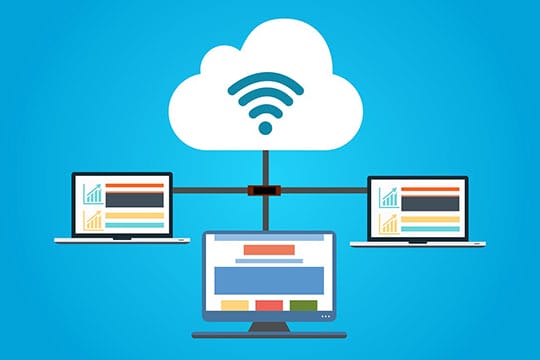Virtual Desktop Infrastructure (VDI) has been around for more than a decade today. But it has been only a recent event that due to the COVID-19 outbreak, the adoption rate of this technology has boomed.
As per this report, the market of VDI that was valued at $4,490 million in 2019 is predicted to reach the value of $12,971.3 million by 2027 with a CAGR of 14.4%.
In VDI, virtual desktops are created over a central server that offers flexibility to the users. The virtual systems can be accessed round the clock from any location. There is no need to be bound to one place to complete any task. That is why many individuals and businesses have started investing in this technology.
Know more about VDI & its future here.
How to connect to VDI?

You can connect to VDI using remote desktop protocol technology like Citrix and VMWare. These solutions will help set up virtual desktops. Following it, specific data transfer rules are created that are displayed on the virtually hosted desktops through a central system. You can select a dedicated virtual desktop and enter dedicated login credentials to get started.
It further provides benefits that include better security with centralization and reduced capital expenses.
Recommended for you: VPN vs RDS vs VDI: What to Choose for a Secure Remote Access?
Misconceptions about Virtual Desktop Infrastructure (VDI)

Before you make up your mind to deploy VDI, you need to understand some misconceptions or myths that revolve around VDI. Here are six points to keep in mind:
Will the personalized changes be automatically saved in VDI?
There are two types of VDIs, persistent and non-persistent. Between these two setups, only persistent VDI can retain personalized changes. Let’s look at both these VDI types to understand better:
- Persistent VDI: All your user configurations and data are saved in the dedicated virtual desktop in this setup. There are devoted virtual machines to ensure the same. So, you can personalize the desktop as per your need and continue from where you left after signing into the system.
- Non-persistent VDI: In this VDI setup, none of the user data or applications are saved once you log out. It is a one-time temporary solution, and personalized changes are not retained with every session.
Misconception #1: Desktop virtualization is complex

When VDI is implemented, there seem to be multiple layers that are operational on a system. For example, there might be two or more virtual desktops running on a single monitor, and there will be numerous log-in options. It can look complicated to its users at first, making them receptive towards choosing desktop virtualization.
Fact:
On the contrary, traditional setups are much more complicated than virtual desktops if compared side by side. Even if there are complex layers, you don’t have to worry about the technicalities. It is pretty easy to access virtual desktops from a single system by logging in with your dedicated details.
Also, it gives you the flexibility to expand the company without implementing an extensive infrastructure system. Therefore, there is no need to monitor each device further, making the process simpler.
Misconception #2: It compromises the performance

A common misconception is that adopting VDI can impact the performance of the workflow. This is because it is often perceived that when desktops are virtualized, the response of on-screen graphics and data load is quite slow.
Fact:
While it must have been true for conventional VDI systems, modern-day technology has made this concept void. Virtual desktops are centralized in an efficient manner and are highly accessible at all times for use.
Furthermore, if you choose hosted solutions for VDI, it would be the responsibility of the cloud provider to offer you best-in-class services for uninterrupted business operations. Information is often stored in redundancy in multiple servers that are geographically isolated. It ensures data can be retrieved even if any of the data centers face any downtime.
Misconception #3: VDI is not secure

Security is one of the biggest concerns for every business. And choosing any new technology solution like VDI can bring in many such worries as well. Various threats, such as cyberattacks, hardware thefts, accidental fires, and system viruses, can impact the privacy and availability of crucial information.
Fact:
When you opt for VDI, you have the option to host it on in-house physical servers or cloud servers. Either way, these setups are much more secure than the traditional systems. The on-premise infrastructure ensures better control and monitoring of each aspect within the network. Therefore, any malicious activity can be tracked down easily. On the other hand, reliable cloud-hosted providers implement security standards that mostly include:
- End-to-end encryption;
- Multiple firewalls;
- Anti-virus and anti-malware;
- Multi-factor authentication;
- OS patching;
- Single Sign-On (SSO);
- Identity management;
- OS hardening;
- Regular backup.
Additionally, even at the physical levels, there are many security measures that can be executed like fire-alarms, 24/7 CCTV coverage, on-premise security personnel, and more.
Misconception #4: VDI is not cost-efficient

Cost can be one of the most significant deciding factors while choosing a technology. It is one of the biggest myths that managing VDI is an expensive task. Therefore, most companies, especially SMBs, can be resistant to investing in virtual desktops.
Fact:
While the upfront costs can be slightly high for VDI compared to traditional methods, the overall cost in the long term is relatively low. There is no need to invest in the physical desktops and update each device regularly.
Furthermore, if you choose cloud-hosted VDI solutions, the cost of local infrastructure, like in-house servers, is eliminated. Hence, it reduces the capital expenses of operating any business.
You may like: COVID-19 Impact on Omnichannel in Retail Sector.
Misconception #5: All VDI providers offer the same thing

When thinking about the VDI market, only the virtualization of desktops might come to your mind. And there might be no difference as to how it is implemented. So, all the service providers might look the same to you.
Fact:
The after-sales services of a competent provider can make a huge difference. Every business has unique requirements. Therefore, it is essential to check a few things before selecting a service vendor. Look for the experience in terms of years and industry type can say a lot about its reliability.
Moreover, if you go for hosted virtual desktops, the cloud providers need to follow certain security standards. Some more factors that need to be evaluated include round-the-clock tech support, budget-friendly plans, refund policy, and trial period. These factors would help give a clear picture of what you are investing your time, money, and efforts for.
Misconception #6: Migrating to cloud-based VDI is hard

Adopting any new technology often comes with many doubts. For example, many myths surround the fact that deploying hosted VDI can take a lot of time, is a complicated process, and might exhaust numerous resources. Also, there is a misconception that it is difficult to adjust to the changes in virtual desktops.
Fact:
Migrating to a hosted virtualized desktop or a DaaS solution is easier than replacing the whole physical desktop system. It only takes a few days, and if you choose a reliable hosting provider, they’ll take care of this process from start to end.
You can personalize your virtual desktops as per your needs. As the look and feel of the cloud-hosted VDI are identical, there is little to no need for product training so that you and your employees can get started with the work process.
On-premise VDI or Cloud-hosted VDI? Which is a better solution?

Both on-premise VDI and cloud-hosted VDI have their set of pros and cons. On one hand, on-premise VDI has local servers that are managed by its end-users. You need to purchase in-house servers and other hardware infrastructure to run on the premises. Furthermore, their operational and maintenance cost is also incurred by you. However, this setup offers more control over the VDI environment.
On the other hand, cloud-hosted VDI offers managed services. There is no need to deploy or invest in on-premise IT infrastructure. Your data is maintained in geographically isolated datacenters. Therefore, even if there is any natural disaster, accidental loss, or any other mishap, your data can be retrieved at any time to ensure business continuity. Moreover, it is essential to choose a reliable provider who takes care of all the IT-related issues and is available round-the-clock for constant support. It not only reduces maintenance costs but also helps you focus more on your core competencies rather than managing the IT infrastructure.
How to choose a hosted VDI vendor?

There are specific things to consider while selecting a cloud provider for VDI. Some of the significant points include:
- Optimized security measures;
- Relevant experience in the field;
- Server uptime guarantee;
- Pay-as-you-go pricing plans;
- Support availability;
- Disaster recovery options;
- Therefore, you must compare all of these factors for an informed decision.
You may also like: 25 Lesser-Known Amazing Windows 10 Features You Need to Know.
Final note

VDI is a powerful tool that has rapidly gained momentum with every business today. But, as for every other technology, it is important to go through every aspect of implementing VDI. Therefore, it is crucial to understand the facts of this technology before you start your investment. If implemented correctly, Virtual Desktop Infrastructure has been a great help for businesses to implement work-from-home policies, making it a necessity rather than a choice for many industries.
This article is written by Bhavleen Kaur. Bhavleen is a content writer at Ace Cloud Hosting, a leading virtual desktop solution provider. She specializes in writing about VDI, DaaS, cloud technology,cloud-based desktop & likes to know about upcoming technology and trends. In her free time, you can find her reading novels or watching movies.





